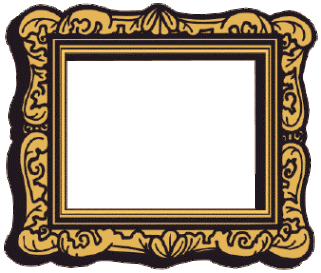Fine Art Valuation: The Frame Factor
The renowned art critic and social commentator John Ruskin once said “Have you ever considered in the early history of painting, how important also is the history of the frame maker? It is a matter, I assure you, needing the very best consideration. For the frame was made before the picture. The painted window is much, but the aperture it fills was thought of before it.” If you were to walk into an art gallery full of empty picture frames hanging on the wall, you would undoubtedly be rather shocked and wonder what was going on. Because the artwork is the primary focus, it is easy to dismiss the picture frame as a mere structural element that does not have any value as an independent entity and does not have any effect on the value of the artwork. Although the picture frame does have a specific function as a protective, decorative, and structural device, the importance of the picture frame goes way beyond its physical functionality.
 Antique picture frames were often crafted specifically for the artwork they would be framing, and were often linked to the artwork with the use of related motifs or similar stylistic attributes. Artists often worked in collaboration with the craftsman to ensure that the frame complemented the artwork and maximised it’s features. It is said, that if you were to purchase a work from Degas and then you changed the frame, Degas would come and find you and rip it down. Whistler made sure that the frames on his paintings wouldn’t be changed by signing the frames instead of the painting, and Seurat painted the frames on his works so that the “frame and the artwork were an integral part of the whole”.
Antique picture frames were often crafted specifically for the artwork they would be framing, and were often linked to the artwork with the use of related motifs or similar stylistic attributes. Artists often worked in collaboration with the craftsman to ensure that the frame complemented the artwork and maximised it’s features. It is said, that if you were to purchase a work from Degas and then you changed the frame, Degas would come and find you and rip it down. Whistler made sure that the frames on his paintings wouldn’t be changed by signing the frames instead of the painting, and Seurat painted the frames on his works so that the “frame and the artwork were an integral part of the whole”.
The explosion of modernism in the 1960’s, which was based on theories of minimalism and abstraction, meant that artworks were often left unframed and those that were, were done so with the intention of making the frame as inconspicuous and plain as possible so as not to detract from the messages and meanings in the artwork itself. This shift in convention caused the functionality of the picture frame to become the primary focus which overshadowed the artistic, cultural and historical aspects of the picture frame. From the 1960’s until the early 80’s the ornate antique picture frames from the 19th and 20th century were considered virtually worthless with dealers and galleries often discarding them and replacing them with the modern minimalist frames that reflected the trends and taste of the time.
The good news is that the importance and value of the picture frame is starting to be realised with dealers, museums and galleries making an effort to match artworks with their original frames or frames from the same period. In fact the history and value of the picture frame has become so important that there have even been exhibitions and auctions devoted solely to the picture frame. Edward Balfour, the owner of frame scouts and auctioneers, Frame Finders, says that “selecting the right frame for a painting is a matter of bringing style, period, and aesthetic together. Done correctly, it’s an investment that can pay off handsomely. A million-dollar Hudson River School painting, for instance, can see it’s value increase by twenty percent with the addition of a proper fluted cove frame, still a relatively modest expense at fifteen to twenty thousand.” There are many recorded instances where the addition of an original or period frame has significantly increased the value of an artwork. The record for a single sale is US$947,000 for a 17th-century amber frame auctioned at Sotheby’s in 1991, and there are many other cases where frames have sold for tens of thousand of dollars. So next time you visit a gallery take some time to appreciate the importance and value of the frame and it’s place in the history of art.
 **Nicholas Forrest is an art market analyst, art critic and journalist based in Sydney, Australia. He is the founder of http://www.artmarketblog.com, writes the art column for the magazine Antiques and Collectibles for Pleasure and Profit and contributes to many other publications.
**Nicholas Forrest is an art market analyst, art critic and journalist based in Sydney, Australia. He is the founder of http://www.artmarketblog.com, writes the art column for the magazine Antiques and Collectibles for Pleasure and Profit and contributes to many other publications.
Filed under: art, art investment, art market, art news, artist, arts, buying art, fine art, uncategorised, world | Tagged: art, art investment, art market, artist, artists, arts, business, exhibition, finance, fine art, gallery, invest, investment, money, museum, news, sculpture, stocks, Uncategorized, world |

































I never really thought about how important the frame is, great article!!